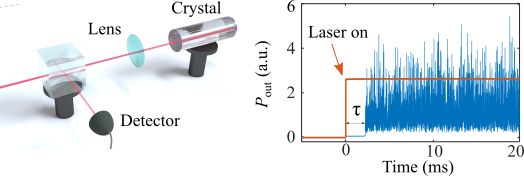Intrinsic Optical Instability
来源: 作者: 发布时间:2022-05-26Yu-Hui Chen
School of Physics, Beijing Institute of Technology, Beijing 100081, China
Advanced photonic technologies rely on many atoms to enhance light-matter interactions. Researcher in Beijing Institute of Technology show that coupling multiple atoms to a laser does not simply scale up, but can lead to chaos.

Left: Schematic of the measurement. A laser is incident from the left side and hits a detector. Right: Measured signal of intrinsic optical instability.
While single atoms interact weakly with electromagnetic fields and sophisticated techniques are required to probe them, ensembles of atoms naturally possess strong light-matter interactions and are thus at the core of many new-generation photonic technologies, such as on-chip laser sources and optical quantum memories. The effect of multiple atoms is often summed up as they are non-interacting ones. However, this picture is not always justified because atom-atom interactions remain, but in many cases are sheltered in the shadow of decoherence. Neglecting the interactions among neighboring atoms may limit the uncovering of the potential of optical many-body systems, as they can undergo various phase transitions and give rise to fundamentally new states compared to an isolated model.
Decades ago it was known that a bistable optical phase can be formed when atom-atom interactions are included, which was known as intrinsic optical bistability (IOB). Unlike most examples of optical bistability, where the feedback is external and provided by optical cavities, the feedback of IOB comes from atom-atom interactions. However, atomic ensembles that are driven by a continues-wave laser are in nature nonequilibrium systems, a dynamically stable response of which is not always guaranteed (note that the two possible outputs of bistabilities are still dynamically-stable states). Before one can assume a steady-state response, a straightforward question is that whether there is a dynamical instability for the system under continuous wave driving.
Chen et al have experimentally revealed a new phase of intrinsic optically instabilities using an erbium doped crystal [1]. In our experiment, we used a continuous-wave laser with a linewidth of less than 1 kHz to drive an erbium doped yttrium orthosilicate crystal (Er:Y2SiO5). The transmission through the sample became dynamically unstable for increasing laser inputs, and the transient net gain was observed if light passed the sample twice. The optical state change of an erbium atom induced by the laser can make nearby atoms on- or off-resonate with the laser through atom-atom interactions. This effect brings the system to a regime that is out of dynamical equilibrium.
________________________________________
Researchers
Yu-Hui Chen and Xiangdong Zhang, Beijing Institute of Technology, Beijing, China
Sebastian P. Horvath, Department of Physics, Lund University, Lund, Sweden
Jevon J. Longdell, Department of Physics, University of Otago, Dunedin, New Zealand
________________________________________
References
[1] Y.-H. Chen et al., Phys. Rev. Lett. 126, 110601(2021).




